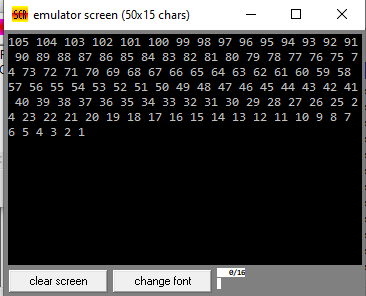I know,it's been 5 years. But This may be helpful to others.
; Here at first, @ indicating start of label and $ indicating start of procedure. if multiple label and procedure is present in assembly code.
; Then distinguishing label & procedure can be done easily. It's just my own way of coding. You can ignore this style
;Algorthm for Decimal Input
; number = 0
; while input != "\n" do
; number = number * 10
; input a charchter
; number = number + input
; count++
;Algorthm for Decimal Output
; for i = 1 to count do
; reminder = number % 10
; push reminder
;
; for i = 1 to count do
; pop reminder
; print reminder
.model small ; declaring this code will be consists of one data segment and one code segment
.stack 100h ; stack is initializeed to offset address at 100h
.data ; this is data segment
n_line db 0ah,0dh,"$" ;here declared a string named n_line which is define byte(8 bit), which value is null('$')
;and 0ah is for line feed (moves to next output line) & 0dh is for carriage return
n dw ? ; n is defne word(16 bit) variable which value is not initialized yet
i db ? ; i is define byte(8 bit) variable which value is not initialized yet
count db ? ; i is define byte(8 bit) variable which value is not initialized yet
reminder db ? ;reminder is define byte(8 bit) variable which value is not initialized yet
flag db 0 ;flag is define byte(8 bit) variable which value is initialized as 0
num dw ? ; num is defne word(16 bit) variable which value is not initialized yet
.code
$set_number proc
@while:
mov ah,1 ; taking input here
int 21h
mov cl,al
sub cl,30h
cmp al,13 ;checking if input is new line or not
je @break_while
mov ax,n ; al = n
mul bl ; al = n * 10
mov n,ax ; n = n * 10
mov ch,0 ;as n variable is dw so...
add n,cx ; n = n + al = (n * 10) + al
inc count ; count = count + 1
jmp @while
@break_while:
ret ; here instruction pointer will jump to the next line of calling this procedure
$set_number endp ; end of procedure
$get_number proc
@for_loop_1_init:
mov i,1d
@for_loop_1:
mov dl,count ; before executing loop,every time i'm storing count variable to al register
cmp i,dl ; it means here, cmp i,count
jg @for_loop_1_end
mov ah,0 ; here chances may be ah store some value,so clearing ah register
cmp flag,0 ; think like boolean value
jne @try ; suppose, n = 135d .So each time,i'm ensuring quotient is divded & excluding reminder from ah register
mov ax,n
mov flag,1
div bl ; al = ax/bl and ah = reminder
jmp @final
@try:
mov ah,0
div bl
@final:
xor cx,cx ; clearing cx register
mov cl,ah
push cx ;push reminder
inc i
jmp @for_loop_1
@for_loop_1_end:
; uncomment these, if you want to print in row wise
; lea dx,n_line
; mov ah,9
; int 21h
@for_loop_2_init:
mov i,1d
@for_loop_2:
mov al,count ;before executing loop,every time i'm storing count variable to al register
cmp i,al ;it means here, cmp i,count
jg @for_loop_2_end
pop dx ;stack's top value is stored in dx now
add dx,30h ; 30h is equivalent to 48d, means ascii charchter 0
mov ah,2
int 21h
inc i
jmp @for_loop_2
@for_loop_2_end:
ret ; here instruction pointer will jump to the next line of calling this procedure
$get_number endp ; end of procedure
main proc
mov ax,@data
mov ds,ax
mov bl,10d ; bl = 10d
@input:
xor cx,cx ; clearing cx register
call $set_number
@print:
cmp n,0
je @stop
xor ax,ax ; clearing ax register
xor cx,cx ; clearing cx register
xor dx,dx ; clearing dx register
call $get_number
mov dl,32d ; 32d is for space in ascii
mov ah,2
int 21h
;These register can be affected so for futher looping,clearing all
xor ax,ax ; clearing ax register
xor cx,cx ; clearing cx register
xor dx,dx ; clearing dx register
mov count,0
mov flag,0
dec n ; This Question was to print number in decreasing order
mov ax,n
@repeat: ;in this label,i am counting length of n
mov ah,0
div bl
inc count
cmp al,0
jnle @repeat
jmp @print
@stop:
mov ah,4ch ; terminate the programme
int 21h
main endp ; ending of main procedure
end main ; ending of code segment
Output will be look like this, if input = 105
![if input = 105]()


printfwas always doing behind the scenes but now it's not there to help you out. Better start reading aboutDIV. Alternatively, make nested loops to print the units and 10s digits. – Barge10dvalue, that would be "new line feed" in ASCII. Also the 9 to 0 are not printing 0-9 values, but 48-57 values. Which are '0' to '9' digits in ASCII encoding. So if you want to do 100 to 0, you either have to make some algorithm working with 1 to 3 ASCII character values (48-57), or do the actual counting in integer form (from 100 to 0), and convert that number into 1 to 3 ASCII characters (48-57) as needed. As other comments are saying. (I just added this because you say "ascii character value of 10d" = nope) – Gargoyle